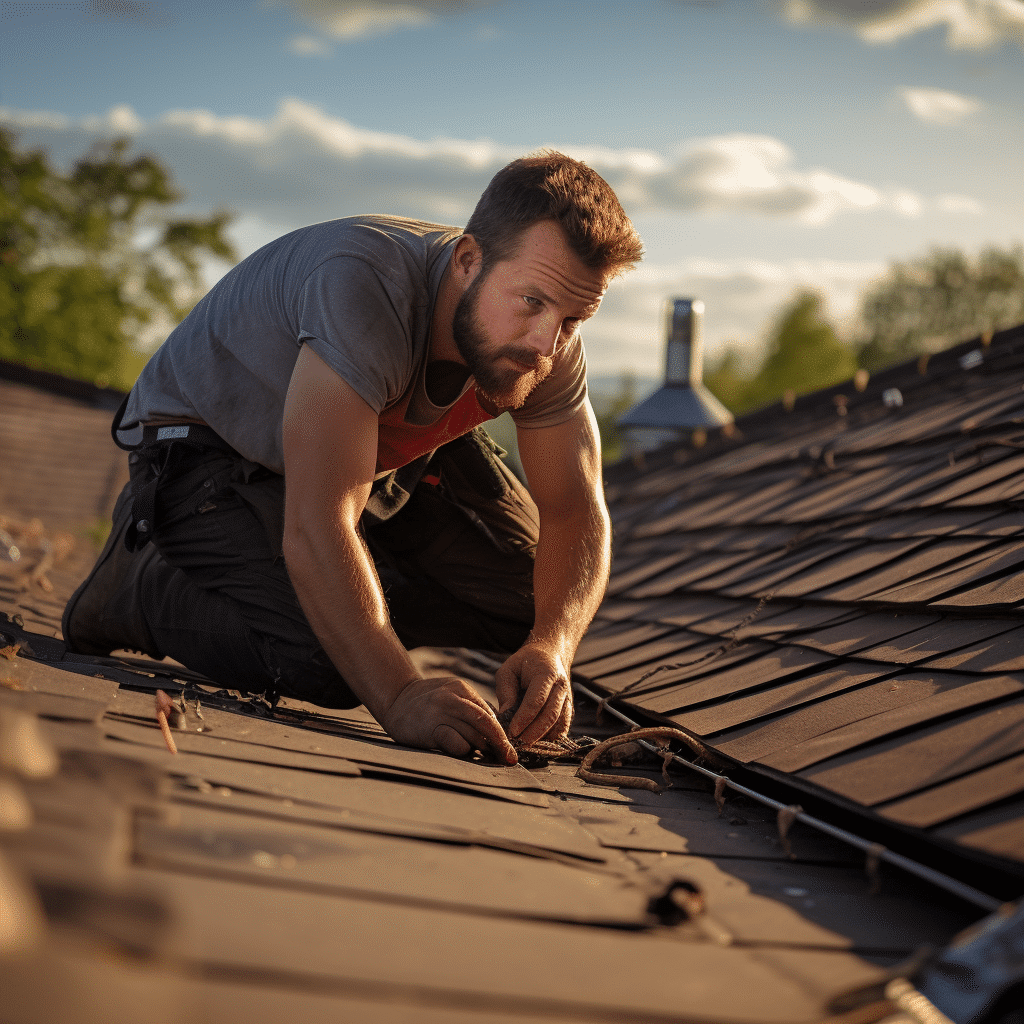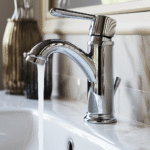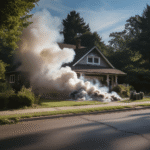Table of Contents
Introduction
A damaged roof can be a huge hassle for homeowners. So, what do you need to do to repair one? Let’s explore!
First, you’ll need to identify the problem. It could be cracked shingles, loose flashing, or an issue with the structure. Inspect your roof and pinpoint the cause of the damage.
Once you know what it is, take action. Patch up leaks with sealant, replace missing shingles, or reinforce weak areas. Make sure to use quality materials for best results. Professional help may be necessary.
It’s important to act fast to prevent further deterioration. Repairing your damaged roof promptly can save you from costly repairs down the line. And it ensures that your home stays safe against the elements for years to come.
Assessing the Damage

It’s important to evaluate roof damage properly. To do this, check the affected areas carefully. This will help you decide what repairs are needed and make a plan.
Types of Damage:
- Dislodged shingles
- Leaks & water stains
- Rot & decay
- Cracks & splits
Recognizing these signs is key to assessing the damage accurately. Roof Repair, Things like missing shingles, leaks, rot, cracks, and splits can indicate how bad the damage is.
Understanding the importance of this step is a must. A complete evaluation can help you address underlying issues that may get worse if not treated. Otherwise, you could face recurring issues or even harm the roof structure.
In the past, inadequate evaluations have caused expensive consequences. By evaluating the damage correctly in the beginning, you can save money and keep your home or business safe.
Gathering the Necessary Tools and Materials
Getting the right tools and materials is key for fixing a broken roof. Without them, the job will be hard and take a long time. Follow this guide to make it easy:
- Make a list: Check the damage. Look for leaks, cracks, and missing shingles. Create a list of all the materials and tools you need for the repair.
- Gather tools: Get a ladder, safety harness, gloves, and goggles for safety. Then collect roofing tools like a hammer, pry bar, utility knife, chalk line, measuring tape, and nail gun. You’ll use these to replace damaged parts.
- Buy the materials: Buy materials that match the style and color of your roof. This could include asphalt shingles, nails or screws, underlayment, flashing tape or sealant, a caulk gun, and roofing cement. Buy extra in case of any unexpected damage.
- Get professional help: If the damage is big or you don’t feel confident, get help from a professional. Licensed contractors know how to repair roofs.
It’s good to check your roof regularly. This can spot problems early and help keep your roof in good shape for up to 25% longer (NRCA).
Preparing the Roof for Repair
- Inspect the Roof:
Check every part of the roof carefully. Look for broken or cracked shingles, loose flashing, and signs of water damage. This will help you understand how much work needs to be done and what materials you’ll need. - Clean and Clear:
Remove any debris that’s blocking drainage systems or hiding potential issues. Clearing the roof also ensures the materials you use will stick better. - Secure Surrounding Areas:
Secure anything nearby that could fall or cause an accident. Cover fragile plants and valuable items with drop cloths.
Remember to wear safety gear and get expert help if needed. Did you know? With proper maintenance, you can extend your roof’s lifespan by up to 15 years, according to Roofing Contractor Magazine.
Repairing the Damaged Roof
Repairing a roof that’s been damaged requires a lot of care and expertise. Here’s a step-by-step guide to help restore your roof’s integrity:
- Assess the Damage: Have a look at your roof for any signs of damage. Missing shingles, leaks, and sagging areas – take note of them and their location.
- Gather Necessary Tools and Materials: Before you start any repairs, make sure you have everything you need. Replacement shingles, roofing nails, roofing cement, a ladder, safety gear, and a hammer.
- Replace Damaged Shingles: Use a pry bar or hammer to carefully remove any broken or missing shingles. Now insert new ones in their place, making sure they’re properly aligned with the existing ones. Secure them with roofing nails or adhesive.
- Fix Leaks: To find where the water’s coming from, check both the interior and exterior of your roof. Use roofing cement to seal small cracks and use flashing to cover bigger gaps.
- Reinforce Weak Areas: Increase the strength of weak spots on the roof by reinforcing them with more roofing material or plywood. This will prevent future damage and give better protection against bad weather.
Apart from these steps, don’t forget safety is key. Wear the right safety gear and ask for professional help if needed.
Bob Vila (renowned home improvement expert) said, “Neglected maintenance is one of the main causes of roof damage.” So make sure to regularly maintain your roof to avoid future repairs.
By following this guide and taking the right precautions, you can repair your damaged roof and keep it safe and sound for years to come.
Roof Sealant and Waterproofing
Do you know about Roof Sealant and Waterproofing? Let’s check out the details:
Silicone:
- Amazingly durable
- Easy to put on
Acrylic:
- Good resistance to weather
- Dries fast
Polyurethane:
- Extremely flexible
- Long-lasting
It’s important to remember that different sealants work best on various roof materials. For instance, asphalt shingles, metal roofs, or flat roofs. Also, the surface should be prepared appropriately before using the sealant for a better result.
Want to save energy? Try reflective roof coatings! According to a study by the U.S. Department of Energy’s Oak Ridge National Laboratory, cool roofs with reflective coatings can reduce air conditioning usage by up to 15%.
Finishing Touches and Maintenance

- Clean Regularly: Keep your roof debris-free! Gently sweep away dirt and dust with a soft brush or broom.
- Inspect for Damage: Check for any signs of damage, like cracked shingles or leaks. Immediately repair these to stop further damage and water infiltration.
- Trim Trees: Branches that hang too close to the roof can cause damage in storms or high winds. Trim them away to reduce risks.
- Safety is also important. Wear protective gear, use stable ladders, and get professional help if needed.
Fun Fact: Finishing touches in roof repair dates back centuries! In ancient civilizations, craftsmen added decorative elements to roof tops for wealth and prestige. Not only did it look good, but it also improved insulation and water runoff.
Maintaining roofs not only keeps it structurally solid, but also adds value and charm to your home. So, prioritize these tasks regularly for a safe, durable and attractive roof!
Conclusion
It’s evident that fixing a broken roof requires attention and expertise. Taking the necessary steps, plus using the right materials, ensures a successful repair. You must assess the damage first, to know whether you need a patch job or a whole replacement. Also, pick the correct roofing stuff and tools.
Roofing repair can be intimidating. Yet, there are people who’ve fixed theirs with determination and resourcefulness. Like John, a single dad. He got help from charities and used recycled materials.
By following this article’s guidelines, anyone can fix their roof. Just ensure your safety, and maybe consider a pro, if needed.
Frequently Asked Questions
1. How do I know if my roof is damaged?
If you notice missing or broken shingles, leaks, sagging, or any signs of wear and tear, it may indicate roof damage.
2. Can I repair the roof myself?
While minor repairs like replacing a few shingles can be done by homeowners, it is recommended to hire a professional for major roof repairs to ensure safety and proper workmanship.
3. How much does roof repair cost?
The cost of roof repairs depends on various factors like the extent of damage, material required, and the size of the roof. It is best to get an estimate from a roofing contractor before proceeding.
4. How long does roof repair take?
The duration of roof repair depends on the complexity of the damage and the weather conditions. It can take a few hours to several days. Your roofing contractor can provide a more accurate timeline.
5. Can I claim insurance for roof repairs?
If the damage was caused by a covered peril stated in your insurance policy, you may be able to claim insurance for roof repairs. Contact your insurance provider to understand the specifics of your policy.
6. How can I prevent future roof damage?
To prevent future roof damage, perform regular inspections, clean gutters regularly, trim overhanging branches, make necessary repairs promptly, and consider installing protective measures like roof coatings or snow guards.


